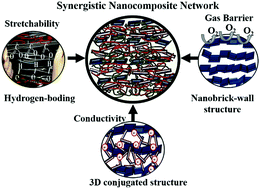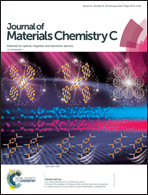Stretchable electrically conductive and high gas barrier nanocomposites†
Abstract
An electrically conductive and stretchable polymer nanocomposite, with high gas barrier behavior, is achieved by depositing trilayers (TL) of polyethylene oxide (PEO), double-walled carbon nanotubes (DWNTs) stabilized with polyacrylic acid (PAA), and graphene oxide (GO) via a layer-by-layer assembly technique. A 40 TL thin film (∼900 nm thick), comprised of this PEO/DWNT-PAA/GO sequence, exhibits an electrical conductivity of 1.3 S cm−1 and a two orders of magnitude reduction in the oxygen transmission rate (OTR) relative to a 1 mm thick polyurethane (PU) rubber substrate. Low temperature thermal reduction of this system further improves the electrical conductivity to 67 S cm−1 and this nanocoating remains crack-free up to 15% strain and maintains a 30 times lower OTR than uncoated polyurethane. This 15% stretch increases resistance by ∼30%. The electrical properties of this unique polymer nanocomposite remain constant after 1000 cycles of bending and twisting. These attributes are provided by the composite's constituents. Elastomeric mechanical properties come from the PEO/PAA layers, electrical conductivity comes from the conjugated network between carbon nanofillers, and the gas barrier is from the GO nanobrick wall structure. This synergistic combination of stretchability, conductivity, and high gas barrier is unprecedented, making this composite interesting for applications in electronics and packaging.



 Please wait while we load your content...
Please wait while we load your content...